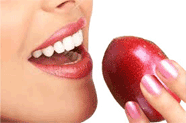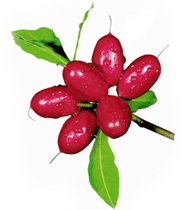 Full List of Fruits
Full List of Fruits  Miracle fruit
Miracle fruitMiracle Fruit
Origin - They are known to originate from Tropical West Africa.
Scientific Name - Synsepalum dulcificum
Appearance - Miracle fruit is small bright red in colour; it is an ellipsoid berry approximately 2 to 3 cm long, with a single seed. The fruit is not sweet as it is, it just has a fleshy pulp which is bland in taste.

For cancer patients:Chemotherapy and anti neurotic drugs frequently affect the receptors on the tongue for which the patient loses the ability to taste.
In many occasion Cancer patients undergoing chemotherapy have metallic taste sensation and worsening health because of their inability to enjoy food.
Miracle Fruit camouflages this effect and removes any unpleasant sensation that they might have.
All the above said fruits will taste really better and far more appealing than before, which kindles even the person who hates to eat fruits and veggies like this, to give it a shot, just to experience the miracle.
The fruit enhances the taste but it never masks the essence or flavor of a food or cuisine. Hot, sour and spicy food would taste sweet, but it will be hot, it canít do anything to the temperature as such.
For diabetic patients: A regular normal diet for a diabetic patient is highly impossible , since they have to cut down on carbs and sugars in order to maintain a proper balance in the glucose levels. Hence people can have this fruit before their meal in order enjoy a tasty meal.

The miracle occurs after eating the fleshy part of the berry. It causes sour and bitter foods to taste sweet.
The fruit contains a glycoprotein called miraculin, which interacts with the taste buds in the mouth, which changes all sour foods to sweet.
When this glycoprotein is activated by the acids which we intake, be it lime or sour food, it forms a giant micro molecule that does magic to your taste buds into not perceiving sourness or bitterness for an hour or more than that.
It does nothing to change the properties of the food, but affects how the taste buds react to the foods. The miracle fruit plant can be grown indoors with a T5 fluorescent growing light.
History of the fruit:
It was a European named Chevalier des Marchais, a French cartographer, who spent most of his life exploring the world, when he was in Africa he came across this miracle fruit, also called and known as magic berry or flavor berry.
He observed that the natives of West Africa would always pop these berries into their mouths before any of their meals, which is mostly a stale bread gruel, sour bread, beer or fermented palm wine, all of which are sour.

















